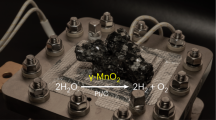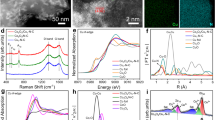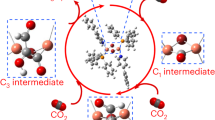Abstract
Electrochemical oxygen reduction has garnered attention as an emerging alternative to the traditional anthraquinone oxidation process to enable the distributed production of hydrogen peroxide. Here, we demonstrate a selective and efficient non-precious electrocatalyst, prepared through an easily scalable mild thermal reduction of graphene oxide, to form hydrogen peroxide from oxygen. During oxygen reduction, certain variants of the mildly reduced graphene oxide electrocatalyst exhibit highly selective and stable peroxide formation activity at low overpotentials (<10 mV) under basic conditions, exceeding the performance of current state-of-the-art alkaline catalysts. Spectroscopic structural characterization and in situ Raman spectroelectrochemistry provide strong evidence that sp2-hybridized carbon near-ring ether defects along sheet edges are the most active sites for peroxide production, providing new insight into the electrocatalytic design of carbon-based materials for effective peroxide production.
This is a preview of subscription content, access via your institution
Access options
Access Nature and 54 other Nature Portfolio journals
Get Nature+, our best-value online-access subscription
$29.99 / 30 days
cancel any time
Subscribe to this journal
Receive 12 digital issues and online access to articles
$119.00 per year
only $9.92 per issue
Buy this article
- Purchase on Springer Link
- Instant access to full article PDF
Prices may be subject to local taxes which are calculated during checkout




Similar content being viewed by others
References
Campos-Martin, J. M., Blanco-Brieva, G. & Fierro, J. L. G. Hydrogen peroxide synthesis: an outlook beyond the anthraquinone process. Angew. Chem. Int. Ed. 45, 6962–6984 (2006).
Seh, Z. W. et al. Combining theory and experiment in electrocatalysis: insights into materials design. Science 355, eaad4998 (2017).
Siahrostami, S. et al. Enabling direct H2O2 production through rational electrocatalyst design. Nat. Mater. 12, 1137–1143 (2013).
Verdaguer-Casadevall, A. et al. Trends in the electrochemical synthesis of H2O2: enhancing activity and selectivity by electrocatalytic site engineering. Nano Lett. 14, 1603–1608 (2014).
Viswanathan, V., Hansen, H. A., Rossmeisl, J. & Norskov, J. K. Unifying the 2e− and 4e− reduction of oxygen on metal surfaces. J. Phys. Chem. Lett. 3, 2948–2951 (2012).
Chen, Z. et al. Development of a reactor with carbon catalysts for modular-scale, low-cost electrochemical generation of H2O2. React. Chem. Eng. 2, 239–245 (2017).
Wagman, D. D. et al. The NBS tables of chemical thermodynamic properties. J. Phys. Chem. Ref. Data 11, 2-37–2-355 (1982).
Mukerjee, S. & Srinivasan, S. Enhanced electrocatalysis of oxygen reduction on platinum alloys in proton exchange membrane fuel cells. J. Electroanal. Chem. 357, 201–224 (1993).
Gasteiger, H. A., Kocha, S. S., Sompalli, B. & Wagner, F. T. Activity benchmarks and requirements for Pt, Pt-alloy, and non-Pt oxygen reduction catalysts for PEMFCs. Appl. Catal. B 56, 9–35 (2005).
Park, J., Nabae, Y., Hayakawa, T. & Kakimoto, M. A. Highly selective two-electron oxygen reduction catalyzed by mesoporous nitrogen-doped carbon. ACS Catal. 4, 3749–3754 (2014).
Jirkovsky, J. S. et al. Single atom hot-spots at Au–Pd nanoalloys for electrocatalytic H2O2 production. J. Am. Chem. Soc. 133, 19432–19441 (2011).
Yang, S., Kim, J., Tak, Y. J., Soon, A. & Lee, H. Single-atom catalyst of platinum supported on titanium nitride for selective electrochemical reactions. Angew. Chem. Int. Ed. 55, 2058–2062 (2016).
Zheng, Z., Ng, Y. H., Wang, D.-W. & Amal, R. Epitaxial growth of Au–Pt–Ni nanorods for direct high selectivity H2O2 production. Adv. Mater. 28, 9949–9955 (2016).
Lee, Y.-H., Li, F., Chang, K.-H., Hu, C.-C. & Ohsak, T. Novel synthesis of N-doped porous carbons from collagen for electrocatalytic production of H2O2. Appl. Catal. B Environ. 126, 208–214 (2012).
Paliteiro, C., Hamnett, A. & Goodenough, J. B. The electroreduction of oxygen on prolytic graphite. J. Electroanal. Chem. 233, 147–159 (1987).
Tammeveski, K., Kontturi, K., Nichols, R. J., Potter, R. J. & Schiffrin, D. J. Surface redox catalysis for O2 reduction on quinone-modified glassy carbon electrodes. J. Electroanal. Chem. 515, 101–112 (2001).
Alvarez-Gallegos, A. & Pletcher, D. The removal of low level organics via hydrogen peroxide formed in a reticulated vitreous carbon cathode cell, Part 1. The electrosynthesis of hydrogen peroxide in aqueous acidic solutions. Electrochim. Acta 44, 853–861 (1998).
Sarapuu, A., Vaik, K., Schiffrin, D. J. & Tammeveski, K. Electrochemical reduction of oxygen on anthraquinone-modified glassy carbon electrodes in alkaline solution. J. Electroanal. Chem. 541, 23–29 (2003).
Yang, H. H. & McCreery, R. L. Elucidation of the mechanism of dioxygen reduction on metal-free carbon electrodes. J. Electrochem. Soc. 147, 3420–3428 (2000).
Xu, J., Huang, W. H. & McCreery, R. L. Isotope and surface preparation effects on alkaline dioxygen reduction at carbon electrodes. J. Electroanal. Chem. 410, 235–242 (1996).
Hasche, F., Oezaslan, M., Strasser, P. & Fellinger, T.-P. Electrocatalytic hydrogen peroxide formation on mesoporous non-metal nitrogen-doped carbon catalyst. J. Energy Chem. 25, 251–257 (2016).
Tao, L. et al. Edge-rich and dopant-free graphene as a highly efficient metal-free electrocatalyst for the oxygen reduction reaction. Chem. Commun. 52, 2764–2767 (2016).
Yan, D. et al. Defect chemistry of nonprecious-metal electrocatalysts for oxygen reactions. Adv. Mater. 29, 1606459 (2017).
Cote, L. J., Kim, F. & Huang, J. Langmuir–Blodgett assembly of graphite oxide single layers. J. Am. Chem. Soc. 131, 1043–1049 (2009).
Eda, G., Fanchini, G. & Chhowalla, M. Large-area ultrathin films of reduced graphene oxide as a transparent and flexible electronic material. Nat. Nanotechnol. 3, 270–274 (2008).
Levich, B. The theory of concentration polarisation. Discuss. Faraday Soc. 1, 37–49 (1947).
Zhou, R. F., Zheng, Y., Jaroniec, M. & Qiao, S. Z. Determination of the electron transfer number for the oxygen reduction reaction: from theory to experiment. ACS Catal. 6, 4720–4728 (2016).
Bonakdarpour, A. et al. Impact of loading in RRDE experiments on Fe–N–C catalysts: two- or four-electron oxygen reduction? Electron. Solid State Lett. 11, B105–B108 (2008).
Lerf, A., He, H., Forster, M. & Klinowski, J. Structure of graphite oxide revisited. J. Phys. Chem. B 102, 4477–4482 (1998).
Acik, M. et al. Unusual infrared-absorption mechanism in thermally reduced graphene oxide. Nat. Mater. 9, 840–845 (2010).
Acik, M. et al. The role of oxygen during thermal reduction of graphene oxide studied by infrared absorption spectroscopy. J. Phys. Chem. C 115, 19761–19781 (2011).
Vijayarangamuthu, K. et al. Temporospatial control of graphene wettability. Adv. Mater. 28, 661–667 (2016).
Bowling, R. J., Packard, R. T. & Mccreery, R. L. Activation of highly ordered pyrolytic-graphite for heterogeneous electron-transfer: relationship between electrochemical performance and carbon microstructure. J. Am. Chem. Soc. 111, 1217–1223 (1989).
Wang, Y., Alsmeyer, D. C. & Mccreery, R. L. Raman-spectroscopy of carbon materials: structural basis of observed spectra. Chem. Mater. 2, 557–563 (1990).
Shen, A. L. et al. Oxygen reduction reaction in a droplet on graphite: direct evidence that the edge is more active than the basal plane. Angew. Chem. Int. Ed. 53, 10804–10808 (2014).
Schultz, B. J., Dennis, Lee, V. & Banerjee, S. An electron structure perspective of graphene interfaces. RSC Adv. 4, 634–644 (2014).
Lee, V. et al. In situ near-edge X-ray absorption fine structure spectroscopy investigation of the thermal defunctionalization of graphene oxide. J. Vac. Sci. Technol. B 30, 061206 (2012).
Kaniyoor, A. & Ramaprabhu, S. The Raman spectroscopic investigation of graphene oxide derived graphene. AIP Adv. 2, 032183 (2012).
Diez-Betriu, X. et al. Raman spectroscopy for the study of reduction mechanisms and optimization of conductivity in graphene oxide thin films. J. Mater. Chem. C 1, 6905–6912 (2013).
Ferrari, A. C. Raman spectroscopy of graphene and graphite: disorder, electron-phonon coupling, doping and nonadiabatic effects. Solid State Commun. 143, 47–57 (2007).
Akhavan, O. The effect of heat treatment on formation of graphene thin films from graphene oxide nanosheets. Carbon 48, 509–519 (2010).
Gao, Y. et al. Combustion synthesis of graphene oxide-TiO2 hybrid materials for photodegradation of methyl orange. Carbon 50, 4093–4101 (2012).
Lin, Y.-C., Lin, C.-Y. & Chiu, P.-W. Controllable graphene N-doping with ammonia plasma. Appl. Phys. Lett. 96, 133110 (2010).
Newman, J. & Thomas-Alyea, K. E. Electrochemical Systems. (John Wiley & Sons, Hoboken, 2004).
McCloskey, B. D. et al. Combining accurate O2 and Li2O2 assays to separate discharge and charge stability limitations in nonaqueous Li–O2 batteries. J. Phys. Chem. Lett. 4, 2989–2993 (2013).
Acknowledgements
B.D.M. and H.W.K. gratefully acknowledge support from the National Science Foundation under grant number CBET-1604927. H.W.K. also acknowledges support from the Basic Science Research Program through the National Research Foundation of Korea funded by the Ministry of Education (2016R1A6A3A03012382). N.K. gratefully acknowledges the Royal Society Newton International Fellowship. P.Y. acknowledges support from the Director of the Office of Science, Office of Basic Energy Sciences as part of the Chemical Sciences, Geosciences, and Biosciences Division of the US Department of Energy, under contract number DE-AC02-05CH11231 within the Catalysis Research Program (FWP number CH030201). The work at Molecular Foundry (XPS and scanning electron microscope) and Advanced Light Source (NEXAFS) was supported by the Office of Science, Office of Basic Energy Sciences of the US Department of Energy under contract number DE-AC02-05CH11231. H.W.K. gratefully acknowledges H. B. Park for guidance on graphene oxide synthesis, W. Kim for FTIR measurement and Y. Hwa for scanning electron microscope analysis. A. C. Luntz is also acknowledged for fruitful discussions on the potential mechanisms of ORR on mrGO materials.
Author information
Authors and Affiliations
Contributions
H.W.K. contributed to the experimental planning, experimental measurements, data analysis and manuscript preparation. M.B.R. and N.K. performed the Raman spectroscopy, including in situ and ex situ measurements. L.Z. measured NEXAFS. J.G. and P.Y. provided experimental guidance for the NEXAFS and Raman measurements, respectively. B.D.M. contributed to the experimental planning, data analysis and manuscript preparation. All authors reviewed and commented on the manuscript before publication.
Corresponding author
Ethics declarations
Competing interests
The authors declare no competing interests.
Additional information
Publisher's note: Springer Nature remains neutral with regard to jurisdictional claims in published maps and institutional affiliations.
Supplementary information
Supplementary Information
Supplementary Figures 1–34, Supplementary Table 1 and Supplementary References.
Rights and permissions
About this article
Cite this article
Kim, H.W., Ross, M.B., Kornienko, N. et al. Efficient hydrogen peroxide generation using reduced graphene oxide-based oxygen reduction electrocatalysts. Nat Catal 1, 282–290 (2018). https://doi.org/10.1038/s41929-018-0044-2
Received:
Accepted:
Published:
Issue Date:
DOI: https://doi.org/10.1038/s41929-018-0044-2
This article is cited by
-
Dithiine-linked metalphthalocyanine framework with undulated layers for highly efficient and stable H2O2 electroproduction
Nature Communications (2024)
-
Mesoporous carbon spheres with programmable interiors as efficient nanoreactors for H2O2 electrosynthesis
Nature Communications (2024)
-
Fullerene-derived boron-doped defective nanocarbon for highly selective H2O2 electrosynthesis
Nano Research (2024)
-
Enhancing Hydrogen Peroxide Production through Modulating the Morphology of N-doped Mesoporous Carbon Electrocatalysts
Catalysis Letters (2024)
-
Precisely Control Relationship between Sulfur Vacancy and H Absorption for Boosting Hydrogen Evolution Reaction
Nano-Micro Letters (2024)



